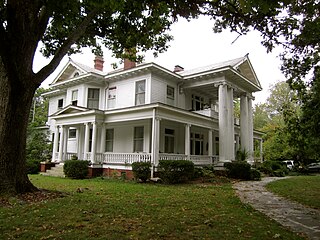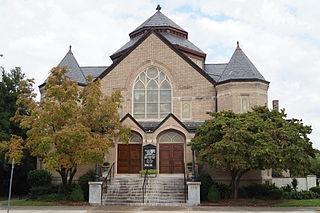
Kinston is a city in Lenoir County, North Carolina, United States, with a population of 19,900 as of the 2020 census. It has been the county seat of Lenoir County since its formation in 1791. Kinston is located in the coastal plains region of eastern North Carolina.

The Monroe Residential Historic District is a national historic district located at Monroe, Union County, North Carolina. It encompasses 376 contributing buildings, 1 contributing site, and 4 contributing objects in a predominantly residential section of Monroe. The district developed between about 1874 and 1940 and includes notable examples of Italianate, Queen Anne, and Classical Revival architecture styles and includes work by architects Wheeler & Stern and by G. Marion Tucker. Notable buildings include the R. V. Houston House, Houston-Redfearn House, the Belk House, J. H. Lee House, M. G. Sheppard House, Elizabeth Friedeman House, former Methodist Parsonage, Gaston Meares House, William E. Cason House, M. G. Sheppard House, and George B. McClellan House.

Halifax Historic District is a national historic district located at Halifax, Halifax County, North Carolina, US that was listed on the National Register of Historic Places in 1970. It includes several buildings that are individually listed on the National Register. Halifax was the site of the signing of the Halifax Resolves on April 12, 1776, a set of resolutions of the North Carolina Provincial Congress which led to the United States Declaration of Independence gaining the support of North Carolina's delegates to the Second Continental Congress in that year.

Downtown Mocksville Historic District is a national historic district located at Mocksville, Davie County, North Carolina. The district encompasses 21 contributing buildings and 1 contributing object in the central business district of Mocksville. It primarily includes residential and commercial buildings with notable examples of Classical Revival and Beaux-Arts style architecture. The district includes the previously listed Davie County Courthouse. Other notable buildings include the Davie County Jail (1916), (former) C. C. Sanford Sons Store (1937), (former) J. T. Baity/Anderson Store, (former) Meroney Hardware Company Building (1922-1924), Sanford Brothers Building (1927), (former) Southern Bank &. Trust Company Building (1923), (former) Princess Theatre, J. T. Angell Building (1910), Horn Service Station, (former) Kurfees and Ward Pure Oil Station, (former) Meroney Filling Station, and Johnstone Office Building (1939).

Fisher Park Historic District is a national historic district in the Fisher Park neighborhood, Greensboro, Guilford County, North Carolina. The district encompasses 541 contributing buildings, 2 contributing sites, and 44 contributing structures in a predominantly residential section of Greensboro. The houses were largely built between the 1900s and 1930s and include notable examples of Queen Anne, Colonial Revival, Gothic Revival, American Foursquare, and Bungalow / American Craftsman-style architecture. Located in the district are the separately listed Dixon-Leftwich-Murphy House, John Marion Galloway House, Julian Price House, and Latham-Baker House. Other notable buildings include the First Presbyterian Church (1928), Holy Trinity Episcopal Church (1922), Gant-McAlister House, and A.J. Schlosser House.

Seventh Avenue Depot District is a national historic district located at Hendersonville, Henderson County, North Carolina. The district encompasses 27 contributing buildings and 1 contributing structure in Hendersonville. The district consists of the frame early 20th century depot, a block of original brick street pavement beside it, twenty-seven stores and warehouses, a hotel, and two houses. Notable buildings include the Queen Anne style J.W. Bailey House, Station Hotel (1912–1922), and American Craftsman style Hendersonville Southern Railway Depot (1902-1904).

Hill–Grainger Historic District, also known as the North Queen Street Area, is a national historic district located at Kinston, Lenoir County, North Carolina, USA. It encompasses 172 contributing buildings in a predominantly residential section of Kinston. The buildings include notable examples of Queen Anne, Colonial Revival, Tudor Revival and Bungalow / American Craftsman style architecture and date between 1900 and 1941. Notable buildings include the (former) Grainger High School, Sarahurst (1902-1904), Vernon Hall (1913-1914), (second) H. C. Hines House (1929), Canady-Sutton House, Hobgood-Sparrow House (1926), (first) H. C. Hines House, and the Fields Rasberry House.

Queen–Gordon Streets Historic District is a national historic district located at Kinston, Lenoir County, North Carolina. It encompasses 20 contributing buildings in a mixed commercial and industrial section of Kinston. The buildings include notable examples of Classical Revival, Beaux-Arts, and Romanesque style architecture and date between 1895 and the mid-1930s. Notable buildings include the Gordon Street Christian Church (1912-1915), (former) U. S. Post Office/Federal Building (1915), Citizens / First National Bank Building (1903), (former) Farmers and Merchants Bank (1924), Canady Building (1899), and the LaRoque and Hewitt Building.
Kinston Commercial Historic District is a national historic district located at Kinston, Lenoir County, North Carolina. It encompasses 30 contributing buildings in a mixed commercial and industrial section of Kinston. The district is considered a boundary increase to the previously listed Queen-Gordon Streets Historic District. The buildings include notable examples of Art Deco and Romanesque style architecture and date between 1896 and 1941. Notable buildings include the Carolina Theatre (1935), Cash Supply Store Building, Spence Motor Company Building, and Ellis Carriage Factory (1908-1914).

Mitchelltown Historic District is a national historic district located at Kinston, Lenoir County, North Carolina. It encompasses 204 contributing buildings in a predominantly residential section of Kinston. The buildings include notable examples of Colonial Revival, Classical Revival, and Bungalow / American Craftsman style architecture and date between 1885 and 1941. Notable buildings include the Adolphus Mitchell House, W. A. Mitchell House, Luther P. Tapp House, H. B. W. Canady House, and Robert B. Scott Bouse.

Tull–Worth–Holland Farm is a historic farm and national historic district located near Kinston, Lenoir County, North Carolina. It encompasses 14 contributing buildings and 1 contributing site. The district includes a significant cross section of domestic and agricultural buildings constructed between 1825 and 1942. The farmhouse was built about 1825, and is a two-story, Federal style frame dwelling. It has a gable roof, exterior end chimneys, and hall-and-parlor plan. Other contributing resources are the Cook's House, privy / chicken house, Delco house, playhouse, barn, stable, cotton gin, five tobacco barns, and a tenant house.

Aberdeen Historic District is a national historic district located at Aberdeen, Moore County, North Carolina. The district encompasses 101 contributing buildings, 1 contributing site, and 2 contributing structures in the town of Aberdeen. It was developed between 1880 and 1940 and includes notable examples of Queen Anne, Classical Revival, and Bungalow / American Craftsman style architecture. Located in the district is the separately listed John Blue House. Other notable buildings include the Postmaster's House, Aberdeen and Asheboro Railroad Building, Page Memorial Library (1907), (former) Union Station (1906), Aberdeen and Rockfish Railroad Building (1904), Bank of Aberdeen, Page Memorial United Methodist Church (1913), (former) Bethesda Presbyterian Church (1906-1907), and Faith Presbyterian Church.
Mill Avenue Historic District is a national historic district located at Jacksonville, Onslow County, North Carolina. The district encompasses 31 contributing buildings, 1 contributing site, and 1 contributing structure in a predominantly residential section of Jacksonville. The district developed after 1890 and includes notable examples of Late Victorian and Bungalow / American Craftsman style architecture. Notable contributing buildings include the Jarman Hotel, Jacksonville Depot, Richard Ward House, Richard Ward Guest House, the Lockamy-Chadwick House, George Bender House (1901), Samuel Ambrose House, the Marine House, Steve Aman House, and the Henrietta Jarman House.

Richlands Historic District is a national historic district located at Richlands, Onslow County, North Carolina. The district encompasses 90 contributing buildings, 2 contributing structures, and 2 contributing objects in the central business district and surrounding residential sections of Richlands. The district largely developed after 1880 and includes notable examples of Late Victorian and I-house style residential architecture. Notable contributing buildings include the Robert D. Thompson House (1908), Daniel Webster Murrill House (1908), the Del Barbee House (1910), the Edwards-Cox House (1915), Isaac Koonce House (1918), George Brooks House (1915), Franck House (1914), Richlands Theater (1936), J. F. Mohn Building (1936), Richlands Supply Company Building (1905), M. B. Steed Store (1911), Peoples Bank Building, Bank of Richlands (1927), First Baptist Church (1920s), and Richlands United Methodist Church (1939).

Farmville Historic District is a national historic district located at Farmville, Pitt County, North Carolina. The district encompasses 330 contributing buildings, 1 contributing site, and 2 contributing structures in the central business district and surrounding residential sections of Farmville. It includes buildings dated from about 1860 to 1942 and notable examples of Colonial Revival, Classical Revival, and Queen Anne style architecture. Notable buildings include the James W. May House, Fields-Rasberry House, Dr. David Morrill House, Warren Parker House, Nannie Smith House, First Christian Church (1910), Emmanuel Episcopal Church (1920), St. Elizabeth Catholic Church, Municipal Building (1928) possibly designed by Benton & Benton, Bank of Farmville (1921) designed by Benton & Benton, Pollard Auto Company Building, Paramount Theatre (1930s), J. Y. Monk Tobacco Warehouse, and East Carolina Railway Office and Freight Station.

Reidsville Historic District is a national historic district located at Reidsville, Rockingham County, North Carolina. It encompasses 324 contributing buildings, 1 contributing site, 11 contributing structures, and 1 contributing object in the central business district and surrounding residential sections of Reidsville. It was developed between about 1865 and 1941, and includes notable examples of Italianate, Queen Anne, American Craftsman, and Classical Revival style architecture. Located in the district are the separately listed Penn House and Gov. David S. Reid House. Other notable buildings include the Oaks-Motley House, Colonel A. J. Boyd House (mid-1870s), Reid Block (1880s), Citizens' Bank Building, William Lindsey and company Tobacco Factory, First Baptist Church, Main Street Methodist Church, Melrose (1909) designed by architect Richard Gambier, R. L. Watt house designed by Willard C. Northup, First Presbyterian Church (1922), St. Thomas Episcopal Church, Grand Theatre, Belvedere Hotel, United States Post Office and Federal Building, and the Municipal Building (1926).

Salisbury Historic District is a national historic district located at Salisbury, Rowan County, North Carolina. The district encompasses 348 contributing buildings and 1 contributing site in the central business district and surrounding residential sections of Salisbury. It includes notable examples of Late Victorian, Colonial Revival, and Bungalow / American Craftsman style architecture. Located in the district are the separately listed Maxwell Chambers House, McNeely-Strachan House, Archibald Henderson Law Office, and the former Rowan County Courthouse. Other notable buildings include the tower of the former First Presbyterian Church (1891-1893), Rowan County Courthouse (1914), Conrad Brem House, Kluttz's Drug Store, Bell Building, Washington Building, Grubb-Wallace Building, Hedrick Block, Empire Hotel, St. Luke's Episcopal Church (1827-1828), Soldiers Memorial A.M.E. Zion Church (1910-1913), U.S. Post Office and Courthouse (1909), City Hall (1926), Salisbury Fire House and City Building (1897).
Varina Commercial Historic District is a national historic district located at Fuquay-Varina, Wake County, North Carolina. The district encompasses 12 contributing buildings in the central business district of Fuquay-Varina. The district developed between about 1899 and 1926, and includes notable examples of early-20th century commercial architecture. Notable buildings include the Union Station, Varina Hotel, Bank of Varina, Varina Garage and Machine Company Building, Drug Store, and Bank of Varina (1926).
Downtown Garner Historic District, also known as Garner's Station, is a national historic district located at Garner, Wake County, North Carolina. The district encompasses 62 contributing buildings and 1 contributing site in the central business district and surrounding residential sections of Garner. The district developed between about 1883 and 1940 and includes notable examples of Queen Anne, Classical Revival, and Bungalow / American Craftsman style architecture. Notable buildings include the Garner Depot, (former) Garner High School (1923), Hayes Chapel Christian Church, H. D. Rand Store, Bank of Garner Building, Section Foreman's Bouse, Joe Broughton Bouse, J. J. Bagwell House, W. L. Brooks House, and D. B. Buffaloe House (1923).
Black Creek Rural Historic District is a national historic district located near Black Creek, Wilson County, North Carolina. It encompasses 68 contributing buildings in a rural area near Black Creek. The district developed after 1787 and includes notable examples of Federal, Georgian, and Greek Revival style architecture. Notable buildings include the Shadrack Dickinson House (1787), Dr. Brooks House, John Woodard House, Stephen Woodard House, and Dr. Stephen Woodard House.



















